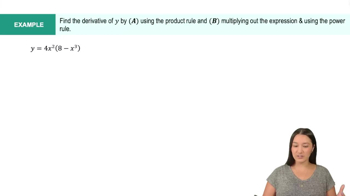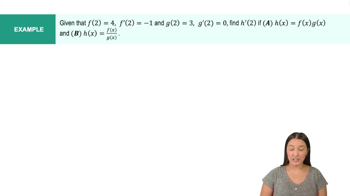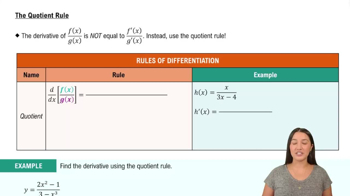Table of contents
- 0. Functions7h 52m
- Introduction to Functions16m
- Piecewise Functions10m
- Properties of Functions9m
- Common Functions1h 8m
- Transformations5m
- Combining Functions27m
- Exponent rules32m
- Exponential Functions28m
- Logarithmic Functions24m
- Properties of Logarithms34m
- Exponential & Logarithmic Equations35m
- Introduction to Trigonometric Functions38m
- Graphs of Trigonometric Functions44m
- Trigonometric Identities47m
- Inverse Trigonometric Functions48m
- 1. Limits and Continuity2h 2m
- 2. Intro to Derivatives1h 33m
- 3. Techniques of Differentiation3h 18m
- 4. Applications of Derivatives2h 38m
- 5. Graphical Applications of Derivatives6h 2m
- 6. Derivatives of Inverse, Exponential, & Logarithmic Functions2h 37m
- 7. Antiderivatives & Indefinite Integrals1h 26m
- 8. Definite Integrals4h 44m
- 9. Graphical Applications of Integrals2h 27m
- 10. Physics Applications of Integrals 2h 22m
3. Techniques of Differentiation
Product and Quotient Rules
Problem 3.5.87.c
Textbook Question
Derivatives of sin^n x Calculate the following derivatives using the Product Rule.
c. d/dx (sin⁴ x)
 Verified step by step guidance
Verified step by step guidance1
First, recognize that the function sin⁴(x) can be rewritten as (sin(x))⁴. This helps in applying the chain rule effectively.
Apply the chain rule: If you have a function u(x) raised to a power n, the derivative is n * u(x)^(n-1) * u'(x). Here, u(x) = sin(x) and n = 4.
Calculate the derivative of u(x) = sin(x), which is u'(x) = cos(x).
Substitute u(x) = sin(x) and u'(x) = cos(x) into the chain rule formula: 4 * (sin(x))³ * cos(x).
Simplify the expression to get the derivative: 4 * sin³(x) * cos(x). This is the derivative of sin⁴(x) using the chain rule.
 Verified video answer for a similar problem:
Verified video answer for a similar problem:This video solution was recommended by our tutors as helpful for the problem above
Video duration:
4mPlay a video:
Was this helpful?
Key Concepts
Here are the essential concepts you must grasp in order to answer the question correctly.
Product Rule
The Product Rule is a fundamental differentiation technique used when finding the derivative of a product of two functions. It states that if you have two functions, u(x) and v(x), the derivative of their product is given by d/dx [u(x)v(x)] = u'(x)v(x) + u(x)v'(x). This rule is essential for calculating derivatives where functions are multiplied together, such as in the case of sin^n x.
Recommended video:
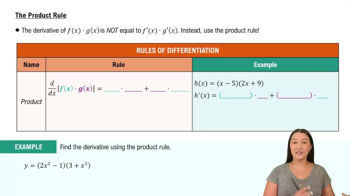
The Product Rule
Chain Rule
The Chain Rule is another critical differentiation rule used when dealing with composite functions. It states that if a function y is composed of another function u, such that y = f(u) and u = g(x), then the derivative is given by dy/dx = dy/du * du/dx. In the context of sin^n x, the Chain Rule is necessary to differentiate the inner function (sin x) raised to a power.
Recommended video:

Intro to the Chain Rule
Higher Order Derivatives
Higher order derivatives refer to the derivatives of a function taken multiple times. For example, the second derivative is the derivative of the first derivative. In the context of sin^n x, understanding higher order derivatives can be important for analyzing the behavior of the function, such as concavity and points of inflection, especially when applying the Product Rule and Chain Rule in more complex scenarios.
Recommended video:
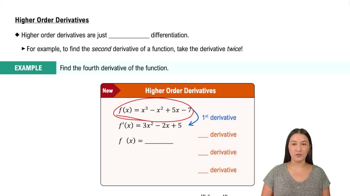
Higher Order Derivatives
Related Videos
Related Practice



